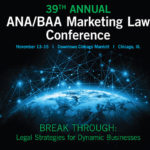 December 7, 2017 4:27 pm
Published by Donna DeClemente
December 7, 2017 4:27 pm
Published by Donna DeClemente
I attended the 39th Annual Marketing Law Conference hosted by the ANA/BAA that took place right before the Thanksgiving Holiday . The... View Article
 November 16, 2016 12:21 pm
Published by Donna DeClemente
November 16, 2016 12:21 pm
Published by Donna DeClemente
We attended the BAA’s 2016 38th Annual Marketing Law Conference which wrapped up last week on Friday, Nov 11th. The organization (Brand... View Article
 November 13, 2015 12:19 pm
Published by Donna DeClemente
November 13, 2015 12:19 pm
Published by Donna DeClemente
The BAA’s 37th Annual Marketing Law Conference just wrapped up on Wednesday, Nov 11th, in Chicago which I was glad to attend.... View Article
 June 10, 2015 1:39 pm
Published by Donna DeClemente
June 10, 2015 1:39 pm
Published by Donna DeClemente
Last week at the 7th annual BlogPaws Conference in Nashville I presented a session titled Key Legal Developments in Sweepstakes, Contests and... View Article




